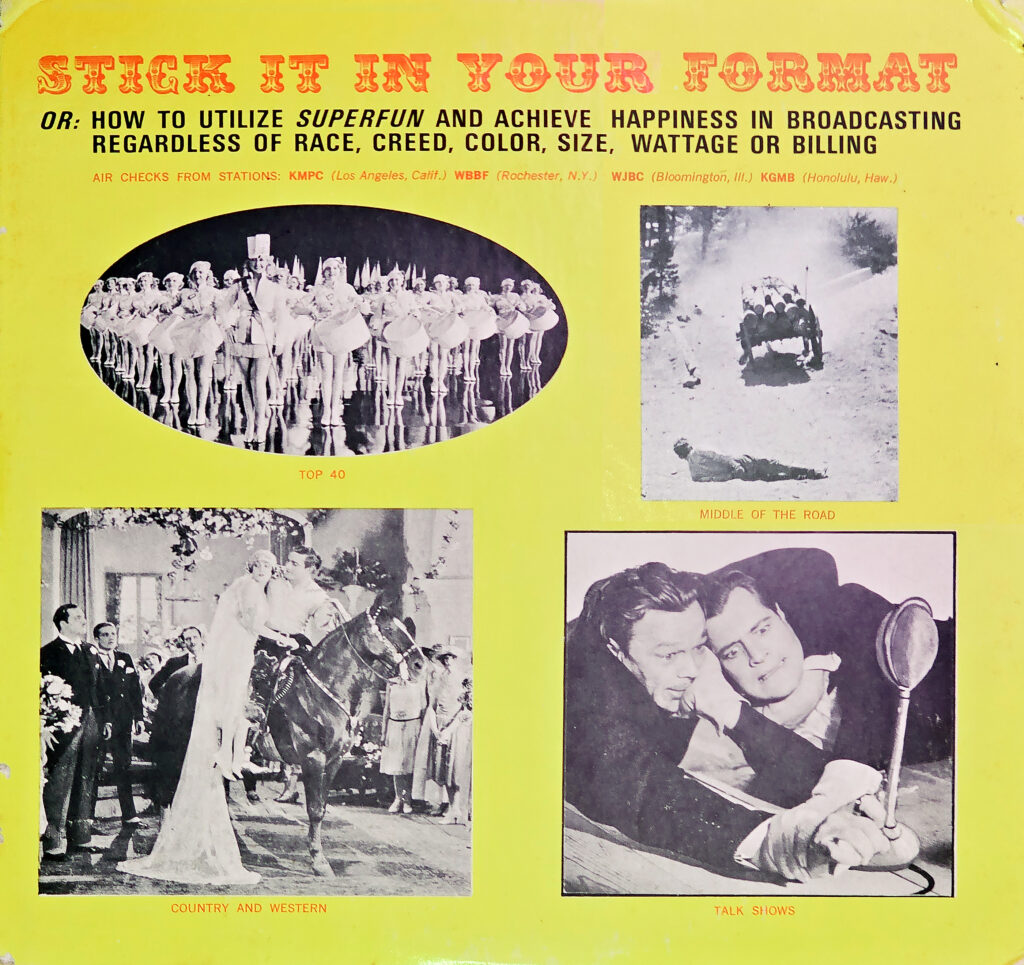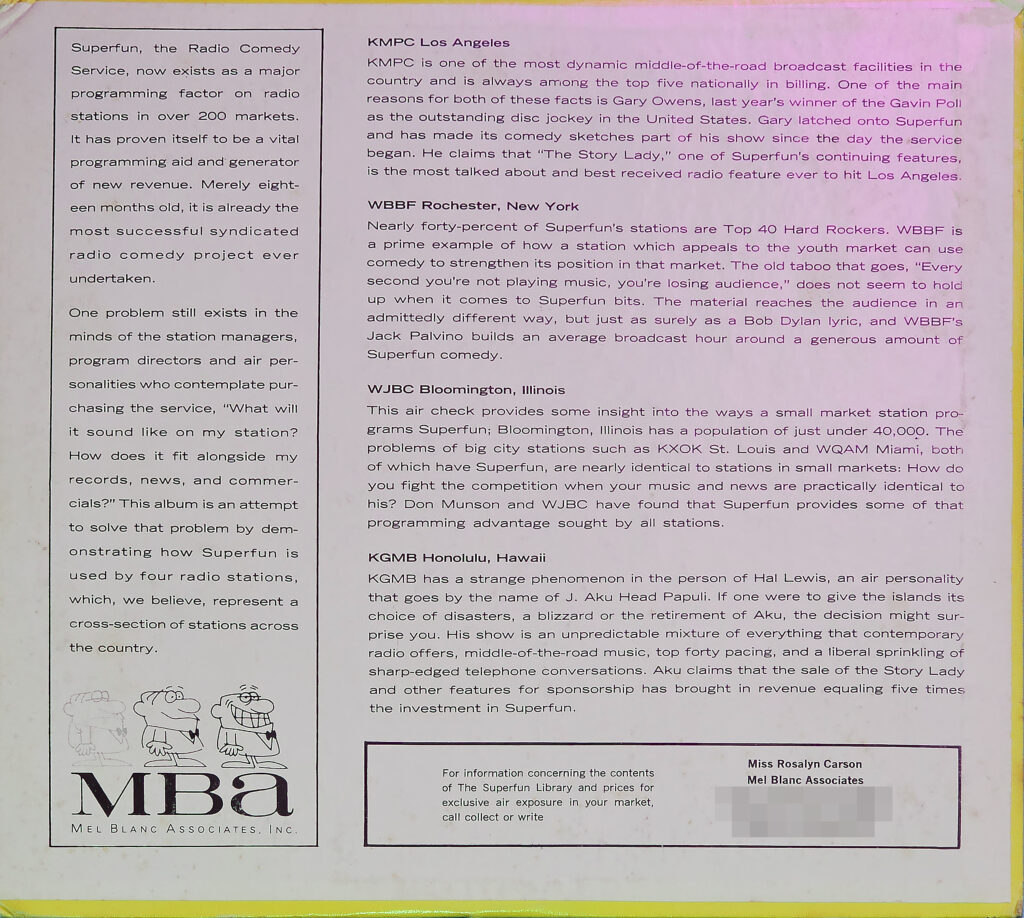Welcome to Finnley’s Audio Adventures. In this blog post, we’re excited to feature a record called “Stick it in your Format”, a follow-up to our previously featured record “Superfun”. This incredible record showcases how the Superfun radio comedy service can be used by disc jockeys and on-air personalities. With examples from noteworthy radio personalities such as Gary Owens of KMPC (Los Angeles), Jack Palvino of WBBF (Rochester, NY), Don Munson of WJBC (Bloomington, IL), and Hal Lewis – AKA J. Akuhead Pupule of KGMB (Honolulu, HI), “Stick it in your Format” is a hilarious and insightful look into the world of radio comedy.

Gary Owens was a prolific American voice actor, disc jockey, and radio personality. His distinctive baritone voice delivered deadpan recitations of total nonsense, which became his signature style as the announcer on Rowan & Martin’s Laugh-In. Owens was equally adept at serious and comedic roles, lending his voice to numerous television shows, commercials, and cartoons.
Owens gained widespread recognition as the voice of the titular superhero on Space Ghost and as Blue Falcon in Dynomutt, Dog Wonder. In 1998, he made an appearance as himself on “Space Ghost Coast to Coast”. Owens’ voice acting career began with the role of Roger Ramjet on the eponymous cartoons.
His radio career began in 1952 as a news reporter at KORN, Mitchell, South Dakota. Two years later, he was promoted to news director, and in 1956, he left KORN for a newscaster job at KMA in Shenandoah, Iowa, before moving on to become a disc jockey at KOIL in Omaha, Nebraska. Owens also worked in Dallas, New Orleans, St. Louis, and at KIMN in Denver before settling in Los Angeles in 1959. He worked at KROY in Sacramento and KEWB in Oakland before joining the staff of 710 KMPC in Los Angeles in 1962, where he remained for the next two decades.

A master of surrealistic humor, Owens was known for his daily appearances by “The Story Lady,” the Rumor of the Day, myriad varieties of “The Nurney Song,” and created the nonsense word “insegrevious,” which was briefly in the Funk & Wagnalls Dictionary. Owens gained notoriety for his entertaining radio advertisements, including a campaign where listeners could request “Yours,” only to receive a postcard from Owens himself with the word “Yours” written on it from the radio station; autographed pictures of the Harbor Freeway in Los Angeles; and his “Moo Cow Report,” in which he and his character Earl C. Festoon reported cows were moving in on the jammed freeways of Los Angeles.
Mel Blanc Audiomedia capitalized on Gary Owens’ Laugh-In popularity by creating and promoting The Gary Owens Special Report, a collection of 260 syndicated radio comedy episodes. In addition to working as a scriptwriter for Jay Ward Productions, Owens had multiple appearances in several Walt Disney series and was involved in creating over 30,000 commercials. Furthermore, he made guest appearances on popular television shows such as The Munsters, I Dream of Jeannie, and McHale’s Navy.
In 1980, Owens was honored with a star on the Hollywood Walk of Fame, located between Walt Disney and Betty White’s stars. He served as the narrator for the World of Motion pavilion at Walt Disney World’s EPCOT Center from 1982 to 1996, and also hosted a television special called “The Roots of Goofy,” which aired from the mid-1980s to the early 1990s.
Owens joined Los Angeles station 1150 KPRZ in 1982 after leaving KMPC, where he hosted morning shows at the “Music of Your Life” adult standards station. This marked a change from his time at KMPC, where he hosted in the afternoon and Dick Whittinghill hosted mornings. The station, originally known as KRLO, began broadcasting from Beverly Hills on February 19, 1927, on various frequencies including 1170 kHz. Its call letters were changed to KEJK in early 1928 and then to KMPC in March 1930, which remained its name for 67 years. The station shifted to 710 kHz after being sold to new owners in November 1929.
The MacMillan Petroleum Company originally owned the station, and its call letters derived from the company’s name. In 1952, Gene Autry, the renowned singer and actor, purchased KMPC and transformed it into the centerpiece of his broadcasting empire, Golden West Broadcasters. Under Autry’s leadership, the station offered a diverse range of programming, including popular music, news, and sports. KMPC served as the flagship station for the Los Angeles Dodgers radio network during the 1958 and 1959 baseball seasons, and in 1961, it became the flagship station for the newly established Los Angeles Angels, which were also owned by Autry. Except for a brief period from 1997 to 2002, KMPC remained the Angels’ radio voice until 2008.
KMPC was sold by the Autry family to ABC in 1994 for $17.5 million. Following the sale, on May 2nd of that year, KMPC began a general talk format to complement ABC’s successful talk station KABC. Later, on February 24, 1997, ABC Radio changed the station’s call letters to KTZN and introduced a women’s talk format. Subsequently, on August 26, 1997, Radio Disney was launched on the station with the KDIS call letters, making it the fifth affiliate of the network. The station continued to broadcast Disney’s children’s radio service until 2003, when it was renamed KSPN and started broadcasting ESPN.
Jack Palvino was a prominent figure in Rochester, New York for more than 40 years due to his prosperous radio career. Palvino, who was born and raised in Rochester, started his job as a morning DJ on WBBF (950 AM) in the late 1950s and continued until 1978. However, his impact on the radio industry in Rochester goes beyond his time at WBBF.
Palvino was among the group of owners who bought WVOR (100.5 FM) in the late 1970s and converted it into Rochester’s primary radio station. Palvino played a significant role in helping WVOR revolutionize the local FM radio scene, ultimately solidifying its position as one of the city’s top stations.
Palvino played a key role as an emcee in introducing various prominent individuals, including political figures like Ronald Reagan and sports icons such as Mickey Mantle, to audiences in Rochester. Palvino’s talent for attracting big names to his radio shows was evident when he hosted a private concert by the Beach Boys before their official performance in Rochester.
Palvino’s impact on the radio industry in Rochester was widely recognized, as evidenced by his induction into both the Rochester Music Hall of Fame in 2013 and the New York State Broadcasters Association Hall of Fame in 2022. These accolades serve as a testament to the lasting impact he had on the city he resided in.
Despite his success on the airwaves, Palvino’s parents had initially wanted him to become a lawyer. He was attending law school at the University at Buffalo when the radio bug bit, leading him to leave law school behind and pursue a career in broadcasting.
Starting at WSAY 1370 AM, he progressed to WGVA and ultimately found a home at WBBF, where his show “Palvino in the Morning” achieved huge success due to its distinctive mix of music and humor. Don Ariano, a longtime engineer, went as far as recording one-liners from notable comedians such as Jonathan Winters and Don Rickles, solely to amuse Palvino.
Since 1947, WBBF has been an integral part of Rochester’s radio landscape, originally known as WWOL. In 1954, WWOL-FM (currently known as WHTT-FM) was established and initially broadcast in tandem with AM 1120. Over a span of five decades, various radio stations in Rochester used the WBBF call letters, including WROC, WBZA, and WFKL, which stopped using the call sign in 2005. Soon after, then-WMNY adopted the WBBF moniker.
The impact of Jack Palvino on Rochester’s radio industry remains indelible, and his heritage serves as a source of motivation for upcoming radio personalities within and beyond the city.
Don Munson, recognized as a renowned radio broadcaster, gained prominence for his remarkable work at WJBC, a radio station situated in Bloomington, Illinois. Munson earned his bachelor’s degree in journalism and communications in 1963 from the University of Illinois at Urbana-Champaign, where he began his career in radio at WKID. It was due to Munson’s exceptional skills and dedication that caught the attention of WJBC Station Manager, Tim Ives, who recruited him as a news reporter in 1964 with a monthly salary of $525.
Munson was initially hired as a disc jockey at WJBC, where he proved to be so skilled that he was granted his own morning show in 1965. The Don ‘Morning’ Munson Show, which ran for 35 years, became his most well-known program. Through this platform, Munson championed causes that he was passionate about, such as organizing a ‘Welcome Home’ parade for veterans of the Vietnam and Korean Wars, many of whom were met with cold or even hostile receptions upon their return. The parade was a triumph, and Munson considers it one of his broadcasting career’s proudest moments.
Munson achieved tremendous success with his show, garnering an unprecedented number of listeners. He holds the record for the most broadcasts in the station’s history. Besides, he actively served on the McLean County Museum of History and the McLean County United Way boards and generously contributed his time to various charitable events and fundraisers when requested.
After being owned by local families Merwin, Ives, and Stevenson, WJBC was acquired by Citadel Broadcasting Corp in 2000, leading to Munson’s departure. Currently, the station is under the ownership of Cumulus Media. Munson has voiced his worries regarding the recent trend of the Federal Communications Commission permitting major conglomerates to possess numerous local radio stations nationwide.
Having been licensed in April 1925 to the Hummer Furniture Store at Second and Joliet streets in La Salle, Illinois, WJBC boasts a rich and extensive history. The call sign, WJBC, was chosen randomly from a list of available call letters. During the “Golden Age of Radio” in the 1940s and 50s, WJBC served as both an NBC Blue Network and an ABC Radio Network affiliate, airing a diverse range of programming such as dramas, comedies, news, sports, and other shows. The Bloomington Broadcasting Company owned WJBC, as well as its FM station, 101.5 WJBC-FM (now WBNQ), which primarily simulcasted WJBC’s programming during the FM station’s first two decades on air.
The station was twice bestowed with the Marconi Award by the National Association of Broadcasters for being the Best Small Market Radio Station in the United States in 2005 and 2009. Furthermore, WJBC has been recognized with multiple awards including Edward R. Murrow Awards for their exceptional coverage of local news and Illinois Silver Dome Awards.
J. Akuhead Pupule, also known as Hal Lewis or simply Aku, was a popular morning radio personality at KGMB, an AM station located in Honolulu, Hawaii during the year 1965. Originally from Brooklyn, New York and named Herschel Laib Hohenstein, Lewis moved to Hawaii in 1946 after his cabaret act failed in San Francisco. He began working as a staff announcer at KGMB and developed his unique presentation style, which involved repetitive time checks. However, a listener became upset after he gave out the wrong time on air, leading to Lewis being referred to as “aku-head.”
After Lewis started using J. Akuhead Pupule, also known as Aku, he created his own record label called Aku Records, which had a green label displaying a cartoon of himself with an exaggerated nose. To promote his label, Lewis convinced Alfred Apaka to record on it, with Aku providing the backing on violin. Moreover, Aku recorded his own music, including “My Little Buckaroo,” showcasing his vocal and violin skills. Aku’s music was played on KORL 650AM and KGU 760AM in Honolulu (previously KPOA) before he eventually settled at KGMB.
KGMB has a long history dating back to 1928, when it started transmitting as KGHB on 1320 kHz, but its callsign changed to KGMB on December 31, 1929. The new callsign was a tribute to George and Margaret Burke, whose initials it mirrored. By January 1, 1937, the station had increased its transmission power to 1,000 watts on 1320 kHz, and in July 1937, it was used in an attempt to locate Amelia Earhart. Finally, in 1939, KGMB relocated to 1534 Kapiolani Blvd and started transmitting on 590 kHz.
KGMB had a significant impact on history when the Japanese used the signal from its transmitter for navigation and direction finding before launching their attack on Pearl Harbor. On the morning of December 7, 1941, a group of B-17s relied on KGMB’s signal to locate Oahu. The Japanese also used the same signal to locate Honolulu and ensure that they maintained complete surprise. This was also mentioned in the report by Scouting Squadron Six of the USS Enterprise.
In 1977, KGMB-AM and TV were purchased by Lee Enterprises. However, KGMB-AM was sold to Clear Channel Communications in 1980 and was later renamed KSSK-AM. The KSSK-AM tower is currently situated on Diamond Head, near the Costco in Iwilei, next to the Kapalama Canal. Over the years, the studio has undergone several relocations. Initially, it was moved from the site where the old Victoria Station restaurant stood at 1601 Kapoilani Blvd to a new location in the same building complex as Office Depot at Colburn and Waikamilo. The studio was later moved to its present location, which is in the former Dole Cannery building that now serves as Clear Channel Communications offices/studios.
Although we may no longer have the pleasure of hearing the voices of Mel Blanc, the talented individuals on the “Superfun” records, and local radio personalities, it’s still delightful to revisit a time when radio stations were truly local, and the person behind the microphone had a deep connection with their audience. Through the use of unique characters, sketches, routines, and services like “Superfun,” these broadcasters were able to create unforgettable and entertaining programs that catered to their specific audience. Unfortunately, corporate-controlled media like “iHeartMedia,” “Cumulus,” and “Townsquare Media” have taken over, and their radio personalities can only provide generic and out-of-touch entertainment that is broadcasted to all markets they serve. As a result, we have lost the charm and authenticity that made local radio so special.
